
Croton, Codiaeum variegatum, is a common houseplant grown for its striking foliage. It is one of six species of broadleaf evergreen perennials, shrubs, and small trees in this genus in the euphorbia family (Euphorbiaceae) which are native to tropical Asia and the western Pacific region (not to be confused with Croton, another genus of more than 700 species in the same family, in which it was formerly incorrectly classified as Croton variegatum). This evergreen shrub or small tree varies widely in leaf color and pattern and numerous cultivars have been developed. It is a tender perennial, hardy only in zones 11-12. In subtropical and tropical climates they are frequently used as landscape shrubs for dramatic hedges, bold focal points in gardens, or potted specimens around buildings.

In its native habitat, croton is a branching, bushy shrub that grows up to 10 feet tall but those offered as houseplants are usually much smaller than the wild plant. The large, thick, leathery leaves are 2 to 12 inches long and quite variable. The shiny, alternate leaves may be linear to oval, have a smooth or lobed margin (sometimes deeply cut to the midrib), and some are wavy or twisted into a spiral. The foliage color ranges from green variegated with white, pink, orange, red, yellow, or purple in various combinations that may change as the leaves age. Markings may follow along the major veins or may be blotches on any part of the leaf blade in regular or random patterns. Sports, or shoots that are completely different in appearance from the parent plant, are not uncommon. As with most plants in the Euphorbiaceae, the milky sap that bleeds from cut stems may cause contact dermatitis in susceptible individuals.

When grown as a houseplant it rarely flowers. When growing in the ground in frost-free climates in spring it produces insignificant flowers in long axillary racemes. The white male flowers with five small petals and 20-30 stamens that give a starburst-like effect are produced on separate inflorescences than the yellowish, petal-less female flowers.

Pollinated female flowers are followed by fruits which are a small tripartite capsule about a third of an inch in diameter containing three small seeds.

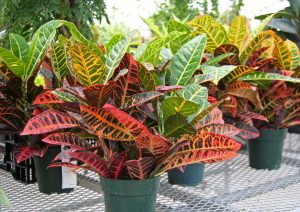
Croton is typically offered as an indoor plant but can also be used outdoors as a seasonal accent plant in containers or plantings of annuals or mixed ornamentals. If growing in containers, indoors or out, think about choosing a pot color that accents the color of the foliage, either echoing one of the leaf colors or something that contrasts with the dominant color. Try combining croton with other tropical plants grown as annuals that have flowers in colors that repeat the color(s) of the leaves, such as orange-flowering lantana, yellow golden shrimp plant, or red pentas. Or choose something with purple flowers, such as angelonia or mealycup sage, to contrast with a croton cultivar with orange and red foliage.
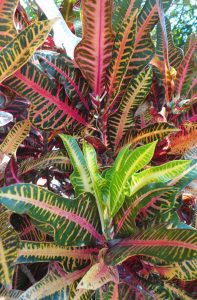
Croton does best in fertile, well-drained, moist soil. They need bright, indirect light when grown indoors. Outdoors they thrive in partial shade, and in cool climates can tolerate full sun if kept moist (and are acclimated first when moved from inside). Higher light produces more vibrant color in the leaves and a more compact plant. The colorful leaves may revert to shades of green in insufficient light, while too much direct sun makes the leaves gray and dull looking. These plants have moderate water needs and should be watered only when the top half-inch to an inch of soil dries out. Reduce watering in the winter. Plants will drop leaves if they are too wet or too dry for extended periods. As a tropical plant, it does best with moderate to high humidity and warm temperatures.
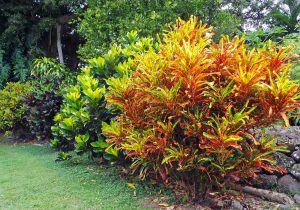
Croton does best at temperatures between 60 and 85ºF, often suffering leaf drop if temperatures remain below 50ºF. Protect them from drafts and severe fluctuations in temperature. Changing environments too quickly can shock the plants and cause leaf drop. Fertilize once or twice during the growing season or more frequently if you want faster growth. Repot when the plant outgrows the container, moving up to a pot only 1-2 inches larger. Plants can be pruned hard in early spring before new growth begins to stimulate branching and new growth if they get leggy. Croton has few pest problems other than the usual insects that commonly infest houseplants (mealybugs, spider mites, scales).
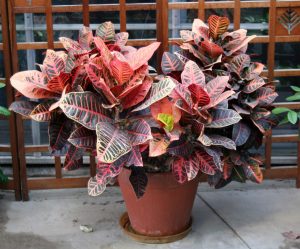
Container-grown plants can be moved outdoors for the growing season once temperatures are consistently above 50ºF, gradually acclimating them to the different light levels outside and moving them back inside in the fall before temperatures drop below 50ºF (colder temperatures can cause leaf loss). Plants used as seasonal plants planted in the ground can be lifted and potted in the fall.
This plant is easily propagated by air layering in spring or by taking softwood cuttings in summer. Although it can be grown from seed, the offspring won’t resemble the parent, so asexual propagation is the only way to maintain specific cultivars.

There are several hundred cultivars of this popular foliage plant, selected and bred to offer a wide diversity of leaf shapes and colors, plant sizes and improved tolerance of low light interior conditions (although the names are often not indicated when offered for sale), including:
- ‘Andreanum’ has broadly oval yellow leaves with gold veins and margins.
- ‘Eleanor Roosevelt’ has long, slender leaves of medium green dotted with golden yellow spots, changing with age to dark red. ‘Franklin Roosevelt’ is similar, but splashed yellow, orange and pink.
-

‘Gold Star’ croton. ‘Evening Embers’ has unusual metallic blue-black leaves highlighted in red and green.
- ‘Gold Dust’ has bright green rounded oval leaves spotted with golden-yellow.
- ‘Gold Star’ is similar to ‘Gold Dust’ with yellow spots splashed across the bright green leaves, but with much narrower leaves.
- ‘Magnificent’ has green and yellow variegated oval-pointed leaves spattered in brilliant shades of red, orange, pink and sometimes bronze or purple.
- ‘Majesticum’ has pendulous branches and linear leaves with yellow midrib veins that mature from deep green to red.
-

‘Mammy’ croton. ‘Mammy’ (or ‘Mammie’) has elongate, twisted, multi-colored leaves tending towards greens and purples with bits of red.
- ‘Oakleaf’ has multicolored leaves with indentations resembling those of an oak leaf in greens to bronzes with red, orange, or yellow veining.
- ‘Petra’ is one of the most common croton varieties available with variously colored bold yellow, pink and orange to red markings along the veins of the dark green pointed-oval leaves that creates an almost lacy appearance when viewed from a distance.
-

‘Petra’ croton. ‘Mrs. Iceton’ or ‘Red Iceton’ has pointed-tipped oval leaves that start out a bright, warm yellow and change into pink and red as they age.
- ‘Spirale’ has narrow red and green leaves that twist in a spiral.
- ‘Thai String’ has multicolored, very narrow leaves.
- ‘Zanzibar’ has long, slender, grassy-looking leaves in shades of purple, red, orange, and gold.

– Susan Mahr, University of Wisconsin – Madison





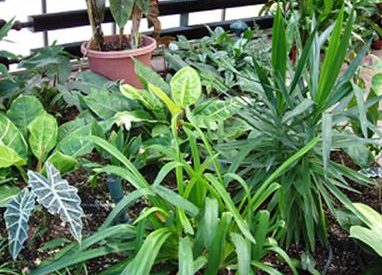 Houseplant Care
Houseplant Care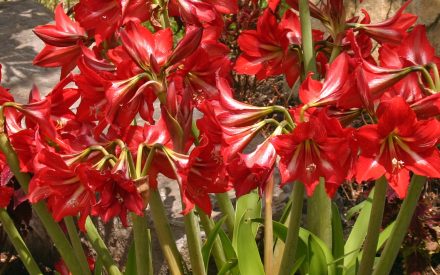 Maintaining Your Festive Houseplants
Maintaining Your Festive Houseplants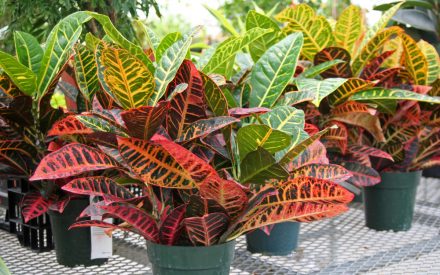 Bringing the Garden Inside
Bringing the Garden Inside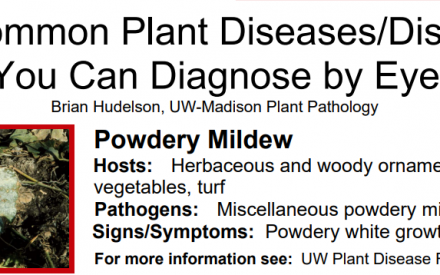 Ten Common Plant Diseases / Disorders You Can Diagnose by Eye
Ten Common Plant Diseases / Disorders You Can Diagnose by Eye


